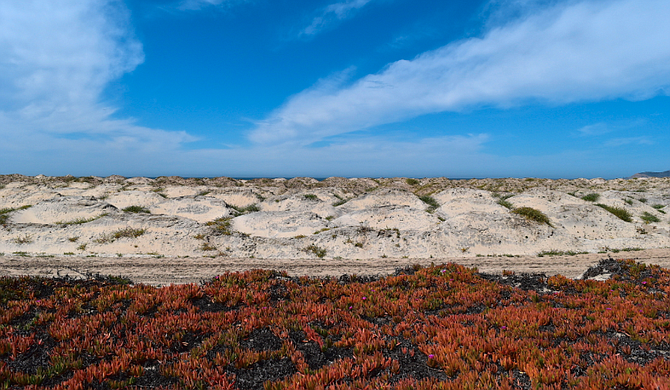 Facebook
Facebook
 X
X
 Instagram
Instagram
 TikTok
TikTok
 Youtube
Youtube

Ocean Water Temperatures, of late in the high 50s Fahrenheit, are finally on the upswing this month as the daylight hours lengthen and the sun arcs higher overhead in the sky each day. It will take about five months of spring and summer sunshine before the ocean’s enormous mass and large heat capacity fully responds to the input of solar energy. A maximum water temperature in the low- to mid-70s is expected sometime between July and September.
Ice Plant is responsible for many of the carpet-like splashes of yellow, pink, red, and purple we’re beginning to see around San Diego. Popular as a ground cover for concealing and stabilizing road cuts or any other easily eroded slope, ice plant covers the shoreline bluffs at La Jolla, road embankments in Rancho Santa Fe and Balboa Park, and front and back yards from Point Loma to El Cajon.
Ceanothus, or wild lilac, begins its annual blooming cycle this month — at least in the warmer coastal areas. Assuming sufficient rainfall arrives, by March virtually every chaparral-covered canyon and hillside on the coastal strip may exhibit blue- or white-flowering specimens. The peak of the ceanothus bloom will work its way eastward, reaching Ramona and Alpine by March or April, and the Palomar, Cuyamaca, and Laguna mountains by April or May. For the next several years, ceanothus growth will be rampant in Cuyamaca Rancho State Park, where the devastating 2003 Cedar wildfire incinerated nearly all of the trees and opened up opportunities for postfire, pioneering vegetation such as the ceanothus species.

Tree Heights can be easily measured this week if the sun shines at midday. On or near February 18, at or very near 12 noon, the sun as seen from San Diego County stands at an altitude of 45 degrees above the horizon. Under those conditions, the length of a shadow cast by a vertical tree trunk on a horizontal surface equals the height of the tree trunk. Even if you lack a measuring tape, you can still use your own feet to pace the distance heel-to-toe: the length of an average adult male’s shoe sole, for example, is very close to one foot.
It’s mid-February, so Orion stands at his highest in the south by about 8 p.m. Here he looks smaller than you probably remember him appearing early in the winter when he was low. You’re seeing the “Moon illusion” effect. Constellations, not just the Moon, look bigger when they’re low.
The above comes from the Outdoors listings in the Reader compiled by Jerry Schad, author of Afoot & Afield in San Diego County. Schad died in 2011. Planet information from SkyandTelescope.org.


Ocean Water Temperatures, of late in the high 50s Fahrenheit, are finally on the upswing this month as the daylight hours lengthen and the sun arcs higher overhead in the sky each day. It will take about five months of spring and summer sunshine before the ocean’s enormous mass and large heat capacity fully responds to the input of solar energy. A maximum water temperature in the low- to mid-70s is expected sometime between July and September.
Ice Plant is responsible for many of the carpet-like splashes of yellow, pink, red, and purple we’re beginning to see around San Diego. Popular as a ground cover for concealing and stabilizing road cuts or any other easily eroded slope, ice plant covers the shoreline bluffs at La Jolla, road embankments in Rancho Santa Fe and Balboa Park, and front and back yards from Point Loma to El Cajon.
Ceanothus, or wild lilac, begins its annual blooming cycle this month — at least in the warmer coastal areas. Assuming sufficient rainfall arrives, by March virtually every chaparral-covered canyon and hillside on the coastal strip may exhibit blue- or white-flowering specimens. The peak of the ceanothus bloom will work its way eastward, reaching Ramona and Alpine by March or April, and the Palomar, Cuyamaca, and Laguna mountains by April or May. For the next several years, ceanothus growth will be rampant in Cuyamaca Rancho State Park, where the devastating 2003 Cedar wildfire incinerated nearly all of the trees and opened up opportunities for postfire, pioneering vegetation such as the ceanothus species.

Tree Heights can be easily measured this week if the sun shines at midday. On or near February 18, at or very near 12 noon, the sun as seen from San Diego County stands at an altitude of 45 degrees above the horizon. Under those conditions, the length of a shadow cast by a vertical tree trunk on a horizontal surface equals the height of the tree trunk. Even if you lack a measuring tape, you can still use your own feet to pace the distance heel-to-toe: the length of an average adult male’s shoe sole, for example, is very close to one foot.
It’s mid-February, so Orion stands at his highest in the south by about 8 p.m. Here he looks smaller than you probably remember him appearing early in the winter when he was low. You’re seeing the “Moon illusion” effect. Constellations, not just the Moon, look bigger when they’re low.
The above comes from the Outdoors listings in the Reader compiled by Jerry Schad, author of Afoot & Afield in San Diego County. Schad died in 2011. Planet information from SkyandTelescope.org.
Comments